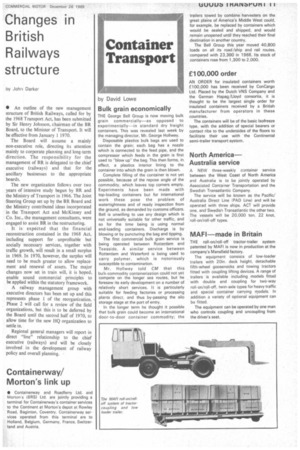Changes in British Railways structure
Page 13

If you've noticed an error in this article please click here to report it so we can fix it.
by John Darker
• An outline of the new management structure of British Railways, called for by the 1968 Transport Act, has been submitted by Sir Henry Johnson, chairman of the BR Board, to the Minister of Transport. It will be effective from January 11970.
The Board will assume a mainly non-executive role, directing its attention mainly to corporate planning and long-term direction. The responsibility for the management of BR is delegated to the chief executive (railways) and that for the ancillary businesses to the appropriate boards.
The new organization follows over two years of intensive study begun by BR and the Ministry of Transport in 1966. The Joint Steering Group set up by the BR Board and the Ministry contributed ideas incorporated in the Transport Act and McKinsey and Co. Inc., the management consultants, were engaged to assist BR in the restructuring.
It is expected that the financial reconstruction contained in the 1968 Act, including support for unprofitable but socially necessary services, together with traffic growth, will result in a small surplus in 1969. In 1970, however, the surplus will need to be much greater to allow replacement and renewal of assets. The major changes now set in train will, it is hoped, enable sound commercial principles to be applied within the statutory framework.
A railway management group with executive directors has been set up and this represents phase I of the reorganization. Phase 2 will call for a review of the field organizations, but this is to be deferred by the Board until the second half of 1970, to allow time for the new HQ organization to settle in.
Regional general managers will report in direct "line" relationship to the chief executive (railways) and will be closely involved in the development of railway policy and overall planning.












































































